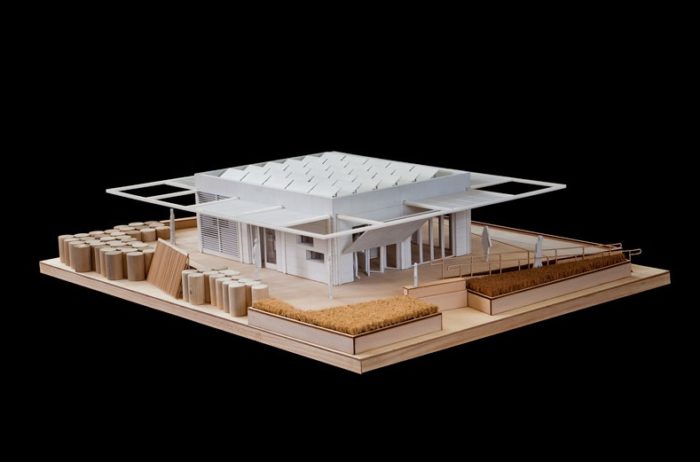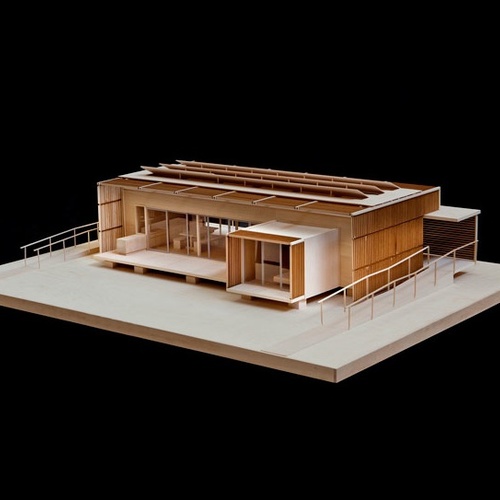
Image Credit: Florida International University
Image Credit: Florida International University PerFORM[D]ance House’s contemporary pavilion-like design includes a basic feature of many traditional homes in the South: a large, well-shaded porch. In terms of comfort and ease of use, the FIU team designed PerFORM[D]ance House for easy access and plenty of cross-ventilation. All four exterior walls are equipped with folding glass doors and sliding screens. The louvered panels that shade the bamboo deck can be manually tilted to further shade the exterior. The panels also can be completely retracted to cover and protect the exterior walls should hurricane-force winds threaten. The kitchen cabinets in PerFORM[D]ance are made of recently harvested American hardwoods, while recycled wood is used in much of the rest of the interior.
In terms of climate, there isn’t much difference between living in South Florida and some of the more inviting parts of the Caribbean just to the south, where the rhythms of warm, sunny, often humid summer days seem to stretch on indefinitely, and where summer-afternoon thunderstorms, an assortment of aggressive insects, and seasonal hurricanes break up the quiet. The Solar Decathlon team representing Florida International University, in North Miami, has designed the “PerFORM[D]ance House,” its entry for the 2011 competition, to exploit the pleasures of this climate while protecting the home’s occupants from its drenching and sometimes buggy outbursts. With about 800 sq. ft. of photovoltaic panels mounted on its flat roof, this square pavilion features folding glass doors (backed by similarly configured screen doors) on all four sides for maximum cross-ventilation. A wide bamboo deck surrounding the entire building is shaded by louvered aluminum panels which can be manually tilted to further block the sun or, in advance of hurricane-force winds, lowered to completely cover the windows.
Live at the International Builder’s Show
The name PerfFORM[D]ance is, in fact, intended as a play on the adjustability of the overhangs, the large deck, the simple shape of the shell, and the easy access to the uncluttered interior, which is serviced by a ductless heating and cooling system. “The idea is the pavilion performs and dances to the interior conditions of its inhabitants, but also the exterior conditions of the local environment,” Manny Dorticos, one of the FIU team’s leaders, explains in the accompanying video. A green take on tradition A south-facing solar thermal array mounted on the grounds near the house provides hot water, reducing the potential load on the PV system. But Dorticos points out that a large portion of the energy savings in a setting such as South Florida is expected to come from the cross-ventilation allowed by building’s open design and the shading options provided by the panel system. The four-square house, with its full-perimeter deck, in fact is a contemporary echo of many traditional Southern homes that include spacious porches with large overhangs.
MORE INFORMATION
GBA’s 2011 Solar Decathlon Resource Guide Florida International’s Solar Decathlon Web page The PerFORM[D]ance House on Facebook DOE Web page for Florida International’s team
With the aim of landing a LEED for Homes rating, the FIU team has been choosy about the materials used. These include American hardwoods (for the kitchen cabinets) and lots of recycled wood for the rest of the interior. Another feature of the PerfFORM[D]ance project is its rainwater management system, which includes graywater bio-filtration swales and planters populated by local plants (such as tickseed flower, mint, sedge grass, switchgrass, buttonbush, and swamp milkweed) and an edible-plant garden. Water collected on the roof flows into the swales and planters via pipes hidden in the exterior walls and in the landscape. What about the cost? Dorticos noted that while the team is pushing to bring construction costs closer to the $250,000 goal identified in the affordability contest – one of 10 Decathlon competitions – at this point PerfFORM[D]ance is pricing at just under $350,000, a figure that, under the circumstances, the team considers “very acceptable.” “Unfortunately there isn’t enough (real-world market) competition to make this technology affordable to the public,” he said. “The idea of this competition as a whole is … so that sustainable design is really part of our lives and becomes the norm for construction.”
For an overview of the Solar Decathlon teams, see GBA’s 2011 Solar Decathlon Resource Guide
Weekly Newsletter
Get building science and energy efficiency advice, plus special offers, in your inbox.















2 Comments
More stats on houses?
I would like to echo some of the previous comments submitted in this forum about these wonderful solar decathlon projects. Can we have more stats about their envelope and energy performance? I know this might take some work to gather, but I know that I would like to see some indication of Total (UA), estimates of internal loads, area+orientation of glazing, and sizing of renewable energy systems. If there are some more, er, exotic(?) systems, (such as natural ventilation features), it would also be great to see how the projects have quantified the performance of these features to test their sufficiency.
Regardless, these all look like wonderful work!
FIU Performdancehouse-more stats on house?
We really appreciate your comment! More calculations will be done, and the topic is actually in the progress of being examined/explored through my thesis project, using mainly Autodesk Ecotect 2011. Thanks!
Log in or create an account to post a comment.
Sign up Log in